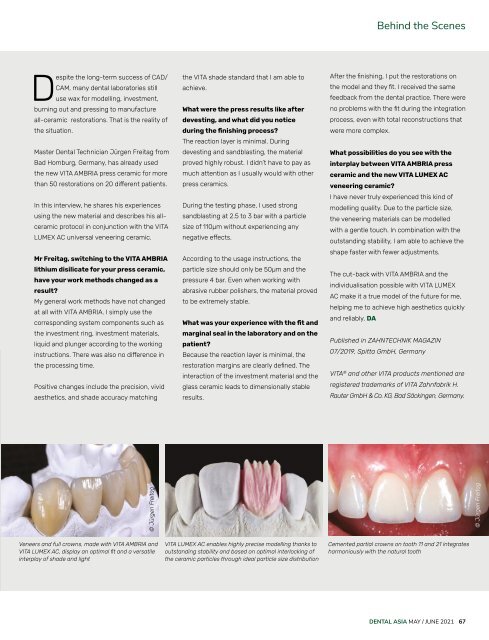Dental Asia May/June 2021
For more than two decades, Dental Asia is the premium journal in linking dental innovators and manufacturers to its rightful audience. We devote ourselves in showcasing the latest dental technology and share evidence-based clinical philosophies to serve as an educational platform to dental professionals. Our combined portfolio of print and digital media also allows us to reach a wider market and secure our position as the leading dental media in the Asia Pacific region while facilitating global interactions among our readers.
For more than two decades, Dental Asia is the premium journal in linking dental innovators and manufacturers to its rightful audience. We devote ourselves in showcasing the latest dental technology and share evidence-based clinical philosophies to serve as an educational platform to dental professionals. Our combined portfolio of print and digital media also allows us to reach a wider market and secure our position as the leading dental media in the Asia Pacific region while facilitating global interactions among our readers.
You also want an ePaper? Increase the reach of your titles
YUMPU automatically turns print PDFs into web optimized ePapers that Google loves.
Behind the Scenes<br />
Despite the long-term success of CAD/<br />
CAM, many dental laboratories still<br />
use wax for modelling, investment,<br />
burning out and pressing to manufacture<br />
all-ceramic restorations. That is the reality of<br />
the situation.<br />
Master <strong>Dental</strong> Technician Jürgen Freitag from<br />
Bad Homburg, Germany, has already used<br />
the new VITA AMBRIA press ceramic for more<br />
than 50 restorations on 20 different patients.<br />
In this interview, he shares his experiences<br />
using the new material and describes his allceramic<br />
protocol in conjunction with the VITA<br />
LUMEX AC universal veneering ceramic.<br />
Mr Freitag, switching to the VITA AMBRIA<br />
lithium disilicate for your press ceramic,<br />
have your work methods changed as a<br />
result?<br />
My general work methods have not changed<br />
at all with VITA AMBRIA. I simply use the<br />
corresponding system components such as<br />
the investment ring, investment materials,<br />
liquid and plunger according to the working<br />
instructions. There was also no difference in<br />
the processing time.<br />
Positive changes include the precision, vivid<br />
aesthetics, and shade accuracy matching<br />
the VITA shade standard that I am able to<br />
achieve.<br />
What were the press results like after<br />
devesting, and what did you notice<br />
during the finishing process?<br />
The reaction layer is minimal. During<br />
devesting and sandblasting, the material<br />
proved highly robust. I didn’t have to pay as<br />
much attention as I usually would with other<br />
press ceramics.<br />
During the testing phase, I used strong<br />
sandblasting at 2.5 to 3 bar with a particle<br />
size of 110μm without experiencing any<br />
negative effects.<br />
According to the usage instructions, the<br />
particle size should only be 50μm and the<br />
pressure 4 bar. Even when working with<br />
abrasive rubber polishers, the material proved<br />
to be extremely stable.<br />
What was your experience with the fit and<br />
marginal seal in the laboratory and on the<br />
patient?<br />
Because the reaction layer is minimal, the<br />
restoration margins are clearly defined. The<br />
interaction of the investment material and the<br />
glass ceramic leads to dimensionally stable<br />
results.<br />
After the finishing, I put the restorations on<br />
the model and they fit. I received the same<br />
feedback from the dental practice. There were<br />
no problems with the fit during the integration<br />
process, even with total reconstructions that<br />
were more complex.<br />
What possibilities do you see with the<br />
interplay between VITA AMBRIA press<br />
ceramic and the new VITA LUMEX AC<br />
veneering ceramic?<br />
I have never truly experienced this kind of<br />
modelling quality. Due to the particle size,<br />
the veneering materials can be modelled<br />
with a gentle touch. In combination with the<br />
outstanding stability, I am able to achieve the<br />
shape faster with fewer adjustments.<br />
The cut-back with VITA AMBRIA and the<br />
individualisation possible with VITA LUMEX<br />
AC make it a true model of the future for me,<br />
helping me to achieve high aesthetics quickly<br />
and reliably. DA<br />
Published in ZAHNTECHNIK MAGAZIN<br />
07/2019, Spitta GmbH, Germany<br />
VITA ® and other VITA products mentioned are<br />
registered trademarks of VITA Zahnfabrik H.<br />
Rauter GmbH & Co. KG, Bad Säckingen, Germany.<br />
© Jürgen Freitag<br />
© Jürgen Freitag<br />
Veneers and full crowns, made with VITA AMBRIA and<br />
VITA LUMEX AC, display an optimal fit and a versatile<br />
interplay of shade and light<br />
VITA LUMEX AC enables highly precise modelling thanks to<br />
outstanding stability and based on optimal interlocking of<br />
the ceramic particles through ideal particle size distribution<br />
Cemented partial crowns on tooth 11 and 21 integrates<br />
harmoniously with the natural tooth<br />
DENTAL ASIA MAY / JUNE <strong>2021</strong> 67


















